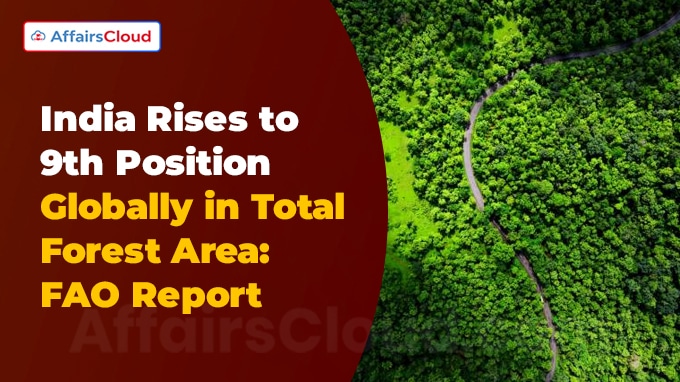On October 21, 2025, Food and Agriculture Organization (FAO) of the United Nations (UN) released a report titled “Global Forest Resource Assessment (GFRA) 2025”. As per the report, India ranks 9th globally with 72.74 million hectares (Mha) of forest cover, representing 2% of the world’s total forests, up from 10th in the previous assessment.
- Russian Federation ranks first globally with 832.6 Mha, accounting for 20% of the world’s forests, followed by Brazil(486.08 Mha) and Canada(368.81 Mha).
Exam Hints:
- What? Release of Report Global Forest Resource Assessment (FRA) 2025
- By? FAO of UN
- Top 5 countries: Russia (1st), Brazil (2nd), Canada (3rd), USA (4th), and China (5th)
- India’s Rank: 9th globally with 72.74 million hectares (Total Forest area)
- Forest Cover to Land: French Guiana (96%) (7.98 Mha)
- Global Forest Gain: ~6.78 Mha/year
- Forest Net Gain: China (1st), Russia (2nd), and India (3rd)
About GFRA Report:
Overview: It provides a global overview of forests, detailing their area, condition, management, and changes over time.
- Conducted every five years since 1948, it has followed consistent five-year reporting cycles since 1990, using standardized data submitted by member countries.
Edition: The 2025 edition marks the 15th edition of the report. This year’s assessment examined 35 years of data from 236 countries, covering three periods: 1990–2000, 2000–2015, and 2015–2025.
Highlights of GFRA Report 2025:
Global Forest Cover:
Overview: Forests cover around 4.06 billion hectares, or 31% of the world’s land, comprising tropical (45%), boreal (27%), temperate (16%), and subtropical (11%) forests.
Top Countries: Russia, Brazil, Canada, the United States of America (USA)(308.9 Mha), and China(227 Mha), together hold more than 50% of the world’s total forest area.
- Australia ranks 6th with 134.0 Mha, the Democratic Republic of the Congo is 7th at 126.2 Mha, Indonesia holds 8th place, and Peru ranks 10th with 68.4 Mha of forest cover.
Global Forest Gain: The world has been adding approximately 6.78 Mha of forest annually, primarily due to restoration initiatives in Asia and Europe.
- Asia recorded the highest net gain in forest area about 1.17 Mha per year between 2010 and 2020.
- Planted forests make up roughly 8% of the global forest area, with Asia contributing 23% of this share, highlighting targeted human-led afforestation and carbon capture initiatives.
Deforestation Trends: The global deforestation rate declined to 10.9 million hectares per year in 2015–2025, down from about 17.6 Mha per year in 1990–2000.
- However, net forest loss(considering both deforestation and forest expansion) has declined over time, from 10.7 Mha per year in 1990–2000 to 4.12 Mha per year in 2015–2025
Forest Decline: Global forest area fell from 4,343.5 Mha in 1990 to 4,140.2 million hectares in 2025, a loss of about 203 Mha over 35 years.
Protected Forests: As of 2025, around 20% of global forests, about 813 Mha, are legally protected, reflecting a gain of 251 million hectares since 1990 and strengthening ecosystem and species conservation.
Forest Cover to Land: French Guiana, with the forest cover of 96% of its land area (7.98 Mha), is the country with the highest forest cover with respect to their land area.
- It is followed by Suriname at second place (94%) (14.674 Mha), Guyana (3rd) (93%) (18.377 Mha), the Federated States of Micronesia (4th) (92%) (0.06 Mha), and Gabon (91%) (23.55 Mha).
Rubber Plantation: Thailand ranked first with the largest areas of rubber plantations of 3.314 Mha, followed by Malaysia at second place (2.181 Mha), China (3rd) (1.554 Mha), and Vietnam (4th) (0.980 Mha).
Top 5 Countries with total forest cover:
| Rank | Country | Total Forest Area in million hectares (Mha) | % of world forest area |
|---|---|---|---|
| 1 | Russian Federation | 832.63 | 20 |
| 2 | Brazil | 486.08 | 12 |
| 3 | Canada | 368.81 | 9 |
| 4 | United States of America (USA) | 308.89 | 7 |
| 5 | China | 227.15 | 5 |
| 9 | India | 72.73 | 2 |
Region-Specific:
Asia: Total forest area of Asia increased slightly from 582 Mha in 1990 to 630 Mha in 2025, with East Asia and Western and Central Asia witnessed growth, and South and Southeast Asia remained relatively stable.
Africa: The total forest area of Africa declined from 779.5 Mha in 1990 to 662.6 Mha in 2025, with large losses in Eastern and Southern Africa and Western and Central Africa. North Africa witnessed a gradual decline, from 44.9 Mha in 1990 to 39 Mha in 2025.
Europe: The total forest area expanded steadily from 997.8 Mha in 1990 to 1,038.9 Mha in 2025.
North & Central America: In South America, the total forest cover has drastically declined from 1,028.4 Mha in 1990 to 848.6 Mha in 2025, largely due to deforestation in the Amazon forest region. North America remained relatively stable, with a minor decline from 735 Mha in 1990 to 744 Mha in 2025.
Oceania: The total forest area in Oceania, comprising Australia, Papua New Guinea, remained relatively stable, varying slightly from 184.4 Mha in 1990 to 183.9 Mha in 2025.
India Specific:
Forest Gain: Between 2015 and 2025, India recorded an annual net forest gain of approximately 191,000 hectares per year, reflecting efforts to expand and restore forested areas.
Net Gain: India ranks third with annual net gain in forest area of 0.191Mha, which is 0.27% of its land area, following China which stands at first place with the gain of 1.686 Mha per year (0.77%) and Russian Federation (2nd) (0.942 Mha) (0.11%).
Community Management: The Joint Forest Management program of Government of India (GOI) significantly increased community-managed forest areas, from zero in 1990 to about 25 Mha by 2015.
Regional: The Northeast region has faced challenges due to deforestation, with Assam facing a loss of 3,400 Square Kilometre (sq km) of tree cover from 2001 to 2024. Western Ghats and Peninsular India contribute significantly to India’s forest carbon stock.
About Food and Agriculture Organization (FAO):
Director-General (DG) – Qu Dongyu
Headquarters – Rome, Italy
Established – 1945





